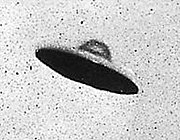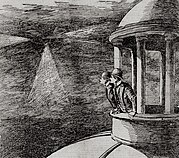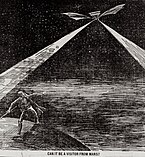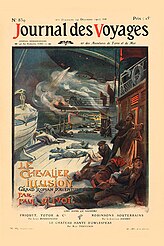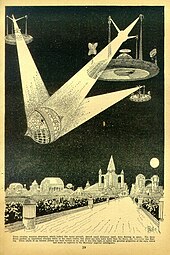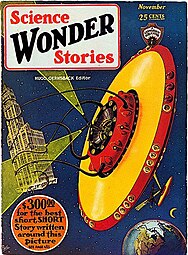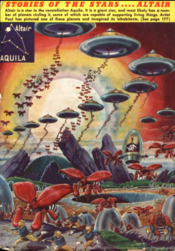
A | B | C | D | E | F | G | H | CH | I | J | K | L | M | N | O | P | Q | R | S | T | U | V | W | X | Y | Z | 0 | 1 | 2 | 3 | 4 | 5 | 6 | 7 | 8 | 9
This article needs additional citations for verification. (April 2024) |
An unidentified flying object (UFO), or unidentified anomalous phenomenon[a] (UAP), is any perceived airborne, submerged or transmedium phenomenon that cannot be immediately identified or explained.[2] Upon investigation, most UAPs are identified as known objects or atmospheric phenomena, while a small number remain unexplained.
While unusual sightings have been reported in the sky throughout history, UFOs became culturally prominent after World War II, escalating during the Space Age. Studies and investigations into UFO reports conducted by governments (such as Project Blue Book in the United States and Project Condign in the United Kingdom), as well as by organisations and individuals have occurred over the years without confirmation of the fantastical claims of believers. The U.S. government currently has two entities dedicated to UAP (or UFO) data collection and analysis: NASA's UAP independent study team and the All-domain Anomaly Resolution Office.
Scientists and skeptic organizations such as the Committee for Skeptical Inquiry have provided prosaic explanations for UFOs, namely that they are caused by natural phenomena, human technology, delusions, and hoaxes. Small but vocal groups of ufologists favour unconventional or pseudoscientific hypotheses, often claiming that UFOs are evidence of extraterrestrial intelligence, technologically advanced cryptids, interdimensional contact or future time travelers, but even after decades of promotion of such ideas by believers and in popular media, the kind of evidence required to solidly support such claims has not been forthcoming. Beliefs surrounding UFOs have inspired parts of new religions even as social scientists have identified the ongoing interest and storytelling surrounding UFOs as a modern example of folklore and mythology understandable with psychosocial explanations.
History
Early history before the 20th century
This section needs additional citations for verification. (January 2024) |
People have always observed the sky and have sometimes seen what, to some, appeared to be unusual sights including phenomena as varied as comets, bright meteors, one or more of the five planets that can be readily seen with the naked eye, planetary conjunctions, and atmospheric optical phenomena such as parhelia and lenticular clouds.[citation needed] One particularly famous example is Halley's Comet: first recorded by Chinese astronomers in 240 BC and possibly as early as 467 BC as a strange and unknown "guest light" in the sky.[citation needed] As a bright comet that visits the inner solar system every 76 years, it was often identified as a unique isolated event in ancient historical documents whose authors were unaware that it was a repeating phenomenon.[citation needed] Such accounts in history often were treated as supernatural portents, angels, or other religious omens.[citation needed] While UFO enthusiasts have sometimes commented on the narrative similarities between certain religious symbols in medieval paintings and UFO reports,[3] the canonical and symbolic character of such images is documented by art historians placing more conventional religious interpretations on such images.[4]
Some examples of pre-contemporary reports about unusual aerial phenomena include:
- Julius Obsequens was a Roman writer who is believed to have lived in the middle of the fourth century AD. The only work associated with his name is the Liber de prodigiis (Book of Prodigies), completely extracted from an epitome, or abridgment, written by Livy; De prodigiis was constructed as an account of the wonders and portents that occurred in Rome between 249 and 12 BCE. An aspect of Obsequens' work that has inspired excitement in some UFO enthusiasts is that he makes reference to things moving through the sky. The descriptions provided bear resemblance to observations of meteor showers. Obsequens was also writing some 400 years after the events he described, thus the text is not an eyewitness account. No corroboration with those amazing sights of old with contemporary observations was mentioned in that work.[5][6]
- Shen Kuo (1031–1095), a Song Chinese government scholar-official and prolific polymath inventor, wrote a vivid passage in his Dream Pool Essays (1088) about an unidentified flying object. He recorded the testimony of eyewitnesses in 11th-century Anhui and Jiangsu (especially in the city of Yangzhou), who stated that a flying object with opening doors would shine a blinding light from its interior (from an object shaped like a pearl) that would cast shadows from trees for ten miles in radius, and was able to take off at tremendous speeds.[7]
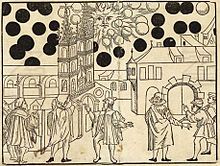
The celestial phenomenon over Basel in 1566. - A woodcut by Hans Glaser that appeared in a broadsheet in 1561 has been featured in popular culture as the "celestial phenomenon over Nuremberg" and connected to various ancient astronaut claims.[8] Skeptic and debunker Jason Colavito argues that the woodcut is "a secondhand depiction of a particularly gaudy sundog", a known atmospheric optical phenomenon.[9] A similar report comes from 1566 over Basel and, indeed, in the 15th and 16th centuries, many leaflets wrote of "miracles" and "sky spectacles" which bear resemblance to natural phenomena which were only more fully characterized after the scientific revolution.[10]
- On January 25, 1878, the Denison Daily News printed an article in which John Martin, a local farmer, had reported seeing a large, dark, circular object resembling a balloon flying "at wonderful speed". Martin, according to the newspaper account, said it appeared to be about the size of a saucer from his perspective, one of the first uses of the word "saucer" in association with a UFO. At the time, ballooning was becoming an increasingly popular and sophisticated endeavor, and the first controlled-flights of such devices were occurring around that time.[11]
- From November 1896 to April 1897, United States newspapers carried numerous reports of "mystery airships" that are reminiscent of modern UFO waves.[12] Scores of people even reported talking to the pilots. Some people feared that Thomas Edison had created an artificial star that could fly around the country. On April 16, 1897, a letter was found that purported to be an enciphered communication between an airship operator and Edison.[13] When asked his opinion of such reports, Edison said, "You can take it from me that it is a pure fake."[14] The coverage of Edison's denial marked the end of major newspaper coverage of the airships in this period.[15]
20th century and after
In the Pacific and European theatres during World War II, round, glowing fireballs known as "foo fighters" were reported by Allied and Axis pilots. Some explanations for these sightings included St. Elmo's fire, the planet Venus, hallucinations from oxygen deprivation, and German secret weapons (specifically rockets).[16] In 1946, more than 2,000 reports were collected, primarily by the Swedish military, of unidentified aerial objects over the Scandinavian nations, along with isolated reports from France, Portugal, Spain, Italy, and Greece. The objects were referred to as "Russian hail" (and later as "ghost rockets") because it was thought the mysterious objects were possibly Russian tests of captured German V1 or V2 rockets, but most were identified as natural phenomena as meteors.[17]
Many scholars, especially those arguing for the psychosocial UFO hypothesis, have noted that UFO characteristics reported after the first widely publicized modern sighting by Kenneth Arnold in 1947 resembled a host of science fiction tropes from earlier in the century.[18][19][20][21][22][23][24]
By most accounts, the popular UFO craze in the USA began with a media frenzy surrounding the reports on June 24, 1947, of a civilian pilot named Kenneth Arnold who described seeing "a group of bat-like aircraft flying in formation at high speeds" near Mount Rainier that he said were "moving like a saucer would if skipped across water" which led to headlines about "flying saucers" and "flying discs".[25][26][27][28] Only weeks after Arnold's story was reported in 1947, Gallup published a poll asking people in the United States what the "flying saucers" might be. Already, 90% had heard of the new term. However, as reported by historian Greg Eghanian, "a majority either had no idea what they could be or thought that witnesses were mistaken" while "visitors from space were not initially among the options that anyone had in mind, and Gallup didn't even mention if anyone surveyed brought up aliens.[26][29][30] Within weeks, reports of flying saucer sightings became a daily occurrence[31] with one particularly famous example being the Roswell incident in 1947 where remnants of a downed observation balloon were recovered by a farmer and confiscated by military personnel.[32] UFO enthusiasts in the early 1950s started to organize local "saucer clubs" modeled after science fiction fan clubs of the 1930s and 1940s, with some growing to national and international prominence within a decade.[26] In 1950, three influential books were published—Donald Keyhoe's The Flying Saucers Are Real, Frank Scully's Behind the Flying Saucers, and Gerald Heard's The Riddle of the Flying Saucers. Each guilelessly proposed that the extraterrestrial UFO hypothesis was the correct explanation and that the visits were in response to detonations of atomic weapons. These books also introduced Americans to, as Eghanian puts it, "the crusading whistleblower dedicated to breaking the silence over the alien origins of unidentified flying objects".[26] Media accounts and speculation ran rampant in the U.S., especially in connection to the 1952 UFO scare in Washington, D.C. so that, by 1953, the intelligence officials (Robertson Panel) worried that "genuine incursions" by enemy aircraft "over U.S. territory could be lost in a maelstrom of kooky hallucination" of UFO reports.[33] A Trendex survey in August 1957, ten years after the Arnold incident, reported that over 25% of the U.S. public "believed unidentified flying objects could be from outer space".[26] The cultural phenomenon showed up within some intellectual works such as the 1959 publication of Flying Saucers: A Modern Myth of Things Seen in the Sky by Carl Jung, a Swiss psychiatrist and psychoanalyst who founded analytical psychology.[34]
Starting in 1947, the U.S. Air Force began to record and investigated UFO reports with Project Sign looking into "more than 250 cases" from 1947 to 1949. It was replaced by Project Grudge up through 1951.[35] In the third U.S. Air Force program, from March 1952 to its termination in December 1969,[36] "the U.S. Air Force cataloged 12,618 sightings of UFOs as part of what is now known as Project Blue Book".[37] In the late 1950s, public pressure mounted for a full declassification of all UFO records, but the CIA played an role in refusing to allow this.[38] This sense was not universal in the CIA, however, as fellow NICAP official Donald E. Keyhoe wrote that Vice Admiral Roscoe Hillenkoetter, the first director of the CIA, "wanted public disclosure of UFO evidence".[39] Official U.S. Air Force interest in UFO reports went on hiatus in 1969 after a study by the University of Colorado led by Edward U. Condon and known as the Condon Report concluded "that nothing has come from the study of UFOs in the past 21 years that has added to scientific knowledge" and that further time investigating UFO reports "cannot be justified".[37]


From the 1960s to 1990s, UFOs were part of American popular culture's obsession with the supernatural and paranormal. In 1961, the first alien abduction account was sensationalized when Barney and Betty Hill underwent hypnosis after seeing a UFO and reported recovered memories of their experience that became ever more elaborate as the years went by.[40] In 1966, 5% of Americans reported to Gallup that "they had at some time seen something they thought was a 'flying saucer'", 96% said "they had heard or read about flying saucers", and 46% of these "thought they were 'something real' rather than just people's imagination".[41] Responding to UFO enthusiasm, there have always been consistent yet less popular efforts made at debunking many of the claims,[26] and at times the media was enlisted including a 1966 TV special, "UFO: Friend, Foe or Fantasy?", in which Walter Cronkite "patiently" explained to viewers that UFOs were fantasy.[33] Cronkite enlisted Carl Sagan and J. Allen Hynek, who told Cronkite, "To this time, there is no valid scientific proof that we have been visited by spaceships".[42]
Such attempts to disenchant the zeitgeist were not very successful at tamping down the mania. Keith Kloor notes that the "allure of flying saucers" remained popular with the public into the 1970s, spurring production of such sci-fi films, as Close Encounters of the Third Kind and Alien, which "continued to stoke public fascination". Meanwhile, Leonard Nimoy narrated a popular occult and mystery TV series In Search of... while daytime talk shows of Mike Douglas, Merv Griffin, and Phil Donahue featured interviews with alien abductees and people who credulously reported stories about UFOs .[26] In the 1980s and 1990s, UFO stories featured in such pulp "true crime" serials as Unsolved Mysteries[43] while the 33 Volume Time-Life series Mysteries of the Unknown which featured UFO stories sold some 700,000 copies.[44] Kloor writes that by the late 1990s, "other big UFO subthemes had been prominently introduced into pop culture, such as the abduction phenomenon and government conspiracy narrative, via best-selling books and, of course, The X-Files".[42]
Eghigian notes that, by this point, the UFO problem had become "far more interesting to ponder than to actually solve."[26] Interest was particularly fevered in the 1990s with the publicity surrounding the television broadcast of an Alien autopsy video marketed as "real footage" but later admitted to be a staged "re-enactment".[45] Eghigian writes that "there had always been outlier abduction reports dating back to the '50s and '60s" but that in the '80s and '90s "the floodgates opened, and with them a new generation of UFO advocates". Leaders among them were the artist Budd Hopkins, horror writer Whitley Strieber, historian David Jacobs, and Harvard psychiatrist John Mack. They all defended the "veracity of those claiming to have been kidnapped, examined, and experimented upon by beings from another world", writes Eghigian, as "new missionaries who simultaneously played the role of investigator, therapist, and advocate to their vulnerable charges".[26] Eghigian says that Mack "signaled both the culmination and end of the headiest days of alien abduction". When Mack began working with and publishing accounts of abductees — or "experiencers", as he called them — in the early 1990s, he brought a sense of legitimacy to "the study of extraterrestrial captivity". By the late 1990s, however, the Harvard Medical School initiated a review of his position which allowed him to retain tenure. However, after this review, as the review board chairman Arnold Relman later put it, Mack was "not taken seriously by his colleagues anymore". Claims of alien abduction have continued, but no other clinicians would continue to speak of them as real in any sense.[26] Nonetheless, these ideas persisted in popular opinion. According to a 1996 poll by Newsweek, 20% of Americans believed that UFOs were more likely to be proof of alien life than to have a natural scientific explanation.[46]
In December 2017, a new round of media attention started when The New York Times broke the story of the secret Advanced Aviation Threat Identification Program that was funded from 2007 to 2012 with $22 million spent on the program.[47][48] Following this story, along with a serious of sensationalized Pentagon UFO videos leaked by members of the program who became convinced that UFOs were genuine mysteries worth investigating, there was an increase in mainstream attention to UFO stories. In July 2021, Harvard astronomer Avi Loeb announced the creation of his Galileo Project which intended to use high-tech astronomical equipment to seek evidence of extraterrestrial artifacts in space and possibly within Earth's atmosphere. This was followed closely by the publication of Loeb's book Extraterrestrial, in which he argued that the first interstellar comet ever observed, 'Oumuamua, might be an artificial light sail made by an alien civilization.[26] Two government sponsored programs, NASA's UAP independent study team and the All-domain Anomaly Resolution Office were charged in part by Congressional fiat to investigate UFO claims more fully,[49][50][51] adopting the new moniker "unexplained aerial phenomenon" (UAP) to avoid associations with past sensationalism.[52] On 17 May 2022, members of the United States House Intelligence Subcommittee on Counterterrorism, Counterintelligence and Counterproliferation held congressional hearings with top military officials to discuss military reports of UAPs.[53] It was the first public congressional hearing into UFO sightings in the US in over 50 years. Another Congressional hearing took place on July 26, 2023, featuring the whistleblower claims of former U.S. Air Force (USAF) officer and intelligence official David Grusch.[54][55][56]
A Harris Poll in 2009 found that 32% of Americans "believe in UFOs".[57] A National Geographic study in June 2012 found that 36% of Americans believe UFOs exist and that 10% thought that they had spotted one.[58] In June 2021 a Pew research poll found that 51% in the United States thought that UFOs reported by people in the military were likely to be evidence of intelligent life from beyond the Earth.[59] In August 2021, Gallup, with a question not specific to military reports, only found that 41% of adults believed some UFOs involve alien spacecraft from other planets. This Gallup poll showed 44% of men and 38% of women believed this. This average of 41% in 2021 was up from 33% in a 2019 Gallup poll with the same question. Gallup further found that college graduates went in 2019 from being the least likely educational group to believe this to being on par in 2021 with adults who have no college education.[60] An October 2022 poll by YouGov only found that 34% of Americans believe that UFOs are likely to involve alien life forms.[61]
Historian Greg Eghigian wrote in August 2021 that "over the last fifty years, the mutual antagonism between paranormal believers and skeptics has largely framed discussion about unidentified flying objects" and that "it often gets personal" with those taking seriously the prospect that UFOs are extraterrestrial in origin dismissing those who consider UFOs to be worth studying as "narrow-minded, biased, obstinate, and cruel" while the skeptics brushed off "devotees" as "naïve, ignorant, gullible, and downright dangerous". Such "mudslinging over convictions is certainly familiar to historians of religion, a domain of human existence marked by deep divisions over interpretations of belief", and science too has found itself engaged increasing amounts of "boundary work" (which is "asserting and reasserting the borders between legitimate and illegitimate scientific research and ideas, between what may and what may not refer to itself as science") with regard to UFO questions. Eghigian points out our current "stark divide did not happen overnight, and its roots lie in the postwar decades, in a series of events that—with their news coverage, grainy images, celebrity crusaders, exasperated skeptics, unsatisfying military statements, and accusations of a government cover-up—foreshadow our present moment".[26]
UFOs have been taken up by religious studies scholars in various scholarly books.[62][63][64] Jeffrey Kripal, chair of the Department of Religion at Rice University, has said that "both the material and the mental dimensions are incredibly important to get a sense of the full picture".[65] As Adrian Horton writes "from The X-Files to Men in Black, Close Encounters of the Third Kind to Star Wars to Marvel, Hollywood has for decades provided an engrossing feedback loop for interest in the extraterrestrial: a reflection of our fears and capaciousness, whose ubiquitous popularity has in turn fueled more interest in UFOs as perennially compelling entertainment tropes not to be taken seriously". Horton observes that these "alien movies have generally reflected shifting cultural anxieties, from the existential terror of nuclear war to foreign enslavement to loss of bodily control". American entertainment has explored both "hostile aliens" as well as the "benevolent, world-expanding encounters" seen in films such as Steven Spielberg's Close Encounters of the Third Kind and E.T. the Extra-Terrestrial.[66] In her research on the relationship of media to UFO beliefs, Diana Walsh Pasulka, a professor of philosophy and religion at the University of North Carolina, says that what is seen on a screen, "if it conforms to certain criteria, is interpreted as real, even if it is not real and even if one knows it is not real" and that "screen images embed themselves in one's brain and memories" in ways that "can determine how one views one's past and even determine one's future behaviors".[67]
Notable cases and incidents
Britain
- The Rendlesham Forest incident was a series of reported sightings of unexplained lights near Rendlesham Forest in Suffolk, England in late December 1980 which became linked with claims of UFO landings.
France
The most notable cases of UFO sightings in France include:
- the Valensole UFO incident in 1965.
- the Trans-en-Provence Case in 1981.
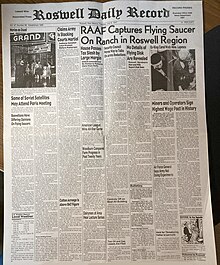
United States
- In the Kecksburg UFO incident, Pennsylvania (1965), residents reported seeing an object crash in the area.
- In 1975, Travis Walton claimed to be abducted by aliens. The movie Fire in the Sky (1993) was based on this event, but greatly embellished the original account.
- The "Phoenix Lights" on March 13, 1997
Astronomer reports
The USAF's Project Blue Book files indicate that approximately 1% of all unknown reports[68] came from amateur and professional astronomers or other telescope users (such as missile trackers or surveyors). In 1952, astronomer J. Allen Hynek, then a consultant to Blue Book, conducted a small survey of 45 fellow professional astronomers. Five reported UFO sightings (about 11%). In the 1970s, astrophysicist Peter A. Sturrock conducted two large surveys of the AIAA and American Astronomical Society (AAS). About 5% of the members polled indicated that they had had UFO sightings.
Astronomer Clyde Tombaugh, who saw six UFOs, including three green fireballs, supported the extraterrestrial hypothesis for UFOs and said scientists who dismissed it without study were "unscientific". Another astronomer, Lincoln LaPaz, headed the United States Air Force's investigation into green fireballs and other UFO phenomena in New Mexico. LaPaz reported two personal sightings, of a green fireball and a disc. (Both Tombaugh and LaPaz were part of Hynek's 1952 survey.) Hynek took two photos through the window of a commercial airliner of a disc that seemed to keep pace with his aircraft.[69]
Astronomer Andrew Fraknoi rejected the hypothesis that UFOs are extraterrestrial spacecraft and responded to the "onslaught of credulous coverage" in books, films and entertainment by teaching his students to apply critical thinking to such claims, advising them that "being a good scientist is not unlike being a good detective". According to Fraknoi, UFO reports "might at first seem mysterious", but "the more you investigate, the more likely you are to find that there is LESS to these stories than meets the eye".[70]
In a 1980 survey of 1800 members of amateur astronomer associations by Gert Helb and Hynek for CUFOS, 24% responded "yes" to the question "Have you ever observed an object which resisted your most exhaustive efforts at identification?"[71]
Famous hoaxes
- The Maury Island incident
- George Adamski, over the space of two decades, made various claims about his meetings with telepathic aliens from nearby planets. He claimed photographs of the far side of the Moon taken by the Soviet lunar probe Luna 3 in 1959 were fake, and that there were cities, trees and snow-capped mountains on the far side of the Moon. Among copycats was a shadowy British figure named Cedric Allingham.
- Ed Walters, a building contractor, in 1987 allegedly perpetrated a hoax in Gulf Breeze, Florida. Walters claimed at first having seen a small UFO flying near his home and took some photographs of the craft. Walters reported and documented a series of UFO sightings over a period of three weeks and took several photographs. These sightings became famous, and are collectively referred to as the Gulf Breeze UFO incident. Three years later, in 1990, after the Walters family had moved, the new residents discovered a model of a UFO poorly hidden in the attic that bore an undeniable resemblance to the craft in Walters' photographs. Most investigators, like the forensic photo expert William G. Hyzer,[72] now consider the sightings to be a hoax.
Terminology
Etymology of key terms
According to Merriam-Webster, "the term UAP first appeared in the late 1960s, while UFO has been around since 1947".[73] The Oxford English Dictionary defines a UFO as "An unidentified flying object; a 'flying saucer'". The first published book to use the word was authored by Donald E. Keyhoe.[74] The term "UFO" (or "UFOB") was adopted as a standard in 1953 by the United States Air Force (USAF) to serve as a catch-all for all such reports. In its initial definition, the USAF stated that a "UFOB" was "any airborne object which by performance, aerodynamic characteristics, or unusual features, does not conform to any presently known aircraft or missile type, or which cannot be positively identified as a familiar object". Accordingly, the term was initially restricted to that fraction of cases which remained unidentified after investigation, as the USAF was interested in potential national security reasons and "technical aspects" (see Air Force Regulation 200-2).
During the late 1940s and through the 1950s, UFOs were often referred to popularly as "flying saucers" or "flying discs" due to the term being introduced in the context of the Kenneth Arnold incident. The Avro Canada VZ-9AV Avrocar was a concept vehicle produced during the 1950s, which was a functional aircraft with a saucer shape.[75] UFOs were commonly referred to colloquially, as a "Bogey" by Western military personnel and pilots during the cold war. The term "bogey" was originally used to report anomalies in radar blips, to indicate possible hostile forces that might be roaming in the area.[76]
The term UFO became more widespread during the 1950s, at first in technical literature, but later in popular use. UFOs garnered considerable interest during the Cold War, an era associated with heightened concerns about national security, and, more recently, in the 2010s, for unexplained reasons.[77][78] Nevertheless, various studies have concluded that the phenomenon does not represent a threat, and nor does it contain anything worthy of scientific pursuit (e.g., 1951 Flying Saucer Working Party, 1953 CIA Robertson Panel, USAF Project Blue Book, Condon Committee).
As an acronym, "UFO" was coined by Captain Edward J. Ruppelt, who headed Project Blue Book, then the USAF's official investigation of UFOs. He wrote, "Obviously the term 'flying saucer' is misleading when applied to objects of every conceivable shape and performance. For this reason the military prefers the more general, if less colorful, name: unidentified flying objects. UFO (pronounced yoo-foe) for short."[79] Other phrases that were used officially and that predate the UFO acronym include "flying flapjack", "flying disc", "unexplained flying discs", and "unidentifiable object".[80][81][82]
In popular usage, the term UFO came to be used to refer to claims of alien spacecraft,[74] and because of the public and media ridicule associated with the topic, some ufologists and investigators prefer to use terms such as "unidentified aerial phenomenon" (UAP) or simply "anomalous phenomena", as in the name of the National Aviation Reporting Center on Anomalous Phenomena (NARCAP).[83] "Anomalous aerial vehicle" (AAV) or "unidentified aerial system" (UAS) are also sometimes used in a military aviation context to describe unidentified targets.[84]
More recently, U.S. officials have adopted the term "unidentified aerial phenomenon"[85] (UAP), sometimes expanded as "unidentified anomalous phenomenon"[86] (see below). As summarized in ETC: A Review of General Semantics, "aside from UAP's more encompassing description, this term avoids the heavy cultural baggage attached to UFO, whose initial association with extraterrestrial origins ...sets up a narrow and inflexible framework for honest scientific research."[87] The term UFO now has decades of association with aliens across many areas of culture, popular entertainment, conspiracy theories, and religious movements as considered in American Cosmic by Diana Walsh Pasulka (published by Oxford in 2019).[88] "Unidentified aerial phenomena (UAP), formerly referred to as UFOs, in theory, could include alien spacecraft, but the two aren't synonymous."[89]
The National Defense Authorization Act for Fiscal Year 2023 (signed into law on December 23, 2022)[90] defined "unidentified anomalous phenomena" in 50 U.S.C. § 3373(n)(8) to include not only "airborne objects" but also "submerged objects or devices" and "transmedium objects or devices" that are not immediately identifiable. In 2023, NASA's UAPIST study team changed the official meaning of the "A" in its name from "Aerial" to "Anomalous" to reflect their new mission as an "All-Anomaly" task force.[90][86]
Extraterrestrial hypothesis
While technically a UFO refers to any unidentified flying object, in modern popular culture the term UFO has generally become synonymous with alien spacecraft;[91] however, the term ETV (extra-terrestrial vehicle) is sometimes used to separate this explanation of UFOs from totally earthbound explanations,[92] including the cryptoterrestrial hypothesis, or from other interpretations of the phenomenon such as the interdimensional hypothesis, the time-traveler hypothesis or the psychosocial hypothesis.
Investigations of reports
UFOs have been subject to investigations over the years that varied widely in scope and scientific rigor. Governments or independent academics in the United States, Canada, the United Kingdom, Japan, Peru, France, Belgium, Sweden, Brazil, Chile, Uruguay, Mexico, Spain, and the Soviet Union are known to have investigated UFO reports at various times. No official government investigation has ever publicly concluded that UFOs are indisputably real, physical objects, extraterrestrial in origin, or of concern to national defense.
Among the best known government studies are the ghost rockets investigation by the Swedish military (1946–1947), Project Blue Book, previously Project Sign and Project Grudge, conducted by the USAF from 1947 until 1969, the secret U.S. Army/Air Force Project Twinkle investigation into green fireballs (1948–1951), the secret USAF Project Blue Book Special Report No. 14[93] by the Battelle Memorial Institute, and the Brazilian Air Force's 1977 Operação Prato (Operation Saucer). France has had an ongoing investigation (GEPAN/SEPRA/GEIPAN) within its space agency Centre national d'études spatiales (CNES) since 1977; the government of Uruguay has had a similar investigation since 1989.
Prosaic explanations
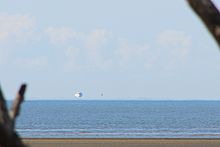
Studies show that after careful investigation, the majority of UFOs can be identified as ordinary objects or phenomena. The most commonly found identified sources of UFO reports are:
- astronomical objects (bright stars, bolides, bright planets, and the Moon) Zdroj:https://en.wikipedia.org?pojem=Unidentified_Aerial_Phenomenon
Text je dostupný za podmienok Creative Commons Attribution/Share-Alike License 3.0 Unported; prípadne za ďalších podmienok. Podrobnejšie informácie nájdete na stránke Podmienky použitia.
Antropológia
Aplikované vedy
Bibliometria
Dejiny vedy
Encyklopédie
Filozofia vedy
Forenzné vedy
Humanitné vedy
Knižničná veda
Kryogenika
Kryptológia
Kulturológia
Literárna veda
Medzidisciplinárne oblasti
Metódy kvantitatívnej analýzy
Metavedy
Metodika
Text je dostupný za podmienok Creative
Commons Attribution/Share-Alike License 3.0 Unported; prípadne za ďalších
podmienok.
Podrobnejšie informácie nájdete na stránke Podmienky
použitia.
www.astronomia.sk | www.biologia.sk | www.botanika.sk | www.dejiny.sk | www.economy.sk | www.elektrotechnika.sk | www.estetika.sk | www.farmakologia.sk | www.filozofia.sk | Fyzika | www.futurologia.sk | www.genetika.sk | www.chemia.sk | www.lingvistika.sk | www.politologia.sk | www.psychologia.sk | www.sexuologia.sk | www.sociologia.sk | www.veda.sk I www.zoologia.sk

